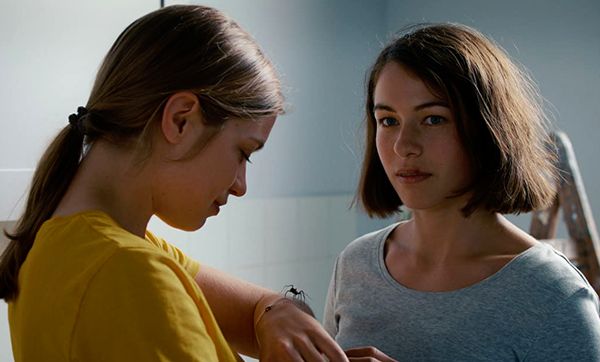 |
| Lisa (Liliane Amuat) and Mara (Henriette Confurius) and the spider in Silvan Zürcher and Ramon Zürcher’s moving tapestry The Girl And The Spider |
Silvan Zürcher and Ramon Zürcher’s The Girl And The Spider (a highlight in the Main Slate of the 59th New York Film Festival), shot by Alexander Haßkerl (The Strange Little Cat), has a great ensemble cast including Henriette Confurius (Dominik Graf’s Beloved Sisters), Liliane Amuat, Dagna Litzenberger-Vinet, Ursina Lardi (Michael Haneke’s The White Ribbon and Anton Corbijn’s A Most Wanted Man), Flurin Giger, André Hennicke (Marc Rothemund’s Sophie Scholl: The Final Days), Lea Draeger (The Strange Little Cat), Ivan Georgiev, Birte Schnöink, Seraphina Schweiger, and Margherita Schoch.
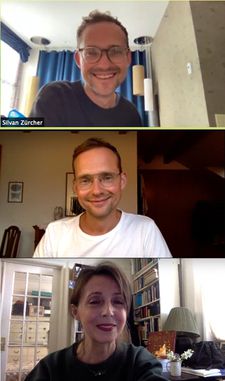 |
| Silvan Zürcher and Ramon Zürcher with Anne-Katrin Titze: “The starting point was to make a film about a move, one character moving from a shared flat to another place.” |
Fairy tales and the Brothers Grimm; animal wrangling including arachnids; François Truffaut and names; a connection between Jurek Kowalski (played by André Hennicke) and Stanley Kowalski in Tennessee Williams’ A Streetcar Named Desire; Peter Fischli & David Weiss’s Der Lauf der Dinge (The Way Things Go, 1987) with Mara (Henriette Confurius) and her cup; question marks in dreams, Haruki Murakami, and Voyage, voyage all came up in the discussion on The Girl And The Spider with spidermen Silvan and Ramon Zürcher.
Moving out and on is stressful. The Zürchers take this deceptively simple and familiar situation and turn it into a reflection on human interactions with other humans, with animals, with objects. Lisa (Liliane Amuat) moves to a new place, Mara stays behind in the apartment they shared. A yellow boxcutter and a blue wig go on a journey, a kettle whistles, a thermos squeaks, and a jackhammer breaks open the asphalt. Mara will hurt her head when she awakes during a thunderstorm from a blown-open window. Who are all these neighbors? Who kidnapped the cat and why does the dog steal all the sponges?
Astrid (Ursina Lardi), Lisa’s mom, is flirting with Kowalski, the repair guy. His assistant Jan (Flurin Giger) turns out to be the film’s Don Juan. The pharmacist’s assistant (Seraphina Schweiger) stocks the shelves unawares that she is being watched from across the street. A piercing on Kerstin’s (Dagna Litzenberger-Vinet) lower lip may drip, and the feathers in a child’s down jacket can cause minor trauma, while technology malfunctions (a warbled PDF, a death cross in an e-mail) will not be repeated. A chambermaid (Birte Schnöink) at sea left behind her piano. Equipped with a good map, a two-day time frame, a sly sense of humour, and a camera that knows where it stands, we are sent out to discover familiar lands anew.
From New York City, Silvan Zürcher and from a family home near Bern in Switzerland, Ramon Zürcher joined me on Zoom for an in-depth conversation on The Girl and the Spider.
Anne-Katrin Titze: Hello again!
Silvan Zürcher: Hello!
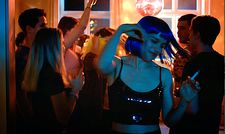 |
| Silvan Zürcher on Lisa (Liliane Amuat) in the blue wig: “It’s these kinds of elements that we were weaving together.” |
Ramon Zürcher: Hello, Anne-Katrin! Again?
AKT: Yes, we talked about The Strange Little Cat in 2014, in-person.
SZ: Oh!
RZ: I remember!
AKT: It was in New York at Criterion. Moving is the main gist of your latest film. That’s the plot part. The rest is about other things. Was the move the starting point of the script?
SZ: Yes, it was at the very beginning. The starting point was to make a film about a move, one character moving from a shared flat to another place. This very idea came because when starting to write the film script, Ramon and I, we still lived together in Berlin and then Ramon decided to move to his own place. So it was in a way this personal experience that led us to choosing this plot, this skeleton. We found it a filmically interesting equation to have this move.
We also liked to set it on two days, not one day as The Strange Little Cat. We were also interested in widening the social range, to have two buildings with several apartments. In a way it was these formal decisions that were our formal limitations and within these limitations, we just started to bundle material. The two of us have notebooks with everyday pearls we write down. So we kind of bundled together pearls and started to weave them together. It was only after when we observed the topic or the themes. And then we tried to shape the material that relates to the topics or the themes.
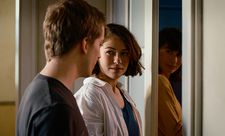 |
| Jan (Flurin Giger) with Mara (Henriette Confurius) and Kerstin (Dagna Litzenberger-Vinet) |
AKT: These bundles of pearls - they are visual, connected to objects? To storytelling? Are they in different bundles? You have great visual links, such as the blue wig that is worn by one person after another. You have animals, for example the dog who loves to steal sponges. At the same time you have characters who stop and tell stories or memories to another. These are all different pearls, different clusters?
SZ: They are. It’s true, when talking about everyday pearls, it’s these kinds of elements that we were weaving together.
RZ: Actually, some pearls are when Mara speaks about how she was in front of the fountain and there were all those children and suddenly she felt so embedded in life, then closing her eyes and re-opening them, suddenly silence was there, as if the fountain had eaten or taken all that. There’s the contrast of that life, and then cut and that emptiness, maybe that for me was also like a small pearl which I had once. Or the old woman who takes the cat. It’s kind of a kidnap situation of a cat to fulfill her life.
AKT: It’s interesting that you bundle these two stories, because both reminded me of Grimm’s fairy tales. The first one reminded me of The Pied Piper of Hamelin, who takes all the children away. And Frau Arnold on the roof, taking the cat, is the classic witch character the protagonists ponder about. There seem to be some childhood fantasies woven into it. Also the haunting story of the down jacket, which is not a classic tale, but a mother telling her daughter that if she pulls out a feather, she’ll have dead poultry inside. This kind of storytelling is very much the fabric of your film, isn’t it?
 |
| Kerstin’s (Dagna Litzenberger-Vinet) lower lip may drip |
RZ: Yes, actually we did not have a very concrete fairy tale in mind during writing, but what we always like about fairy tales is that in a fairy tale there is the reality and there are always elements which are not bound to reality. A little bit as in the books by Murakami. A surrealism, which is linked with naturalism in a reality.
AKT: That makes sense.
RZ: And it treats surrealism or fantasies or strange things as if it were reality. It doesn’t say, that’s a strange thing, it just weaves it in reality and treats it as if it were really the description of reality. Also fairy tales often they are for children but there’s something a bit brutal, often a certain violence. And as you mentioned, the feather in the jacket has something very brutal to evoke in a small child, that in her own jacket could be dead birds. It’s something brutal which maybe can also provoke a very small trauma in a child. It’s not a very visible violence when you can see traces on the skin, it’s an invisible violence which can mark the personal landscape of characters. Those things we like.
AKT: Yes, you like that, it’s very clear from both of your films. Mara pouring coffee over the dog! It’s obvious that you didn’t do that, but there is always the threat of violence. Is the threshold something that you are particularly interested in? The “Schwelle,” the moment right before possible violence?
SZ: Actually it is something we are very much interested in, these passive aggressive moments that are not so obvious, but hidden. Also the storytelling you mentioned before, that the characters start to tell stories within the story. They have their own stories they tell in a way they are monologues rather than dialogues often. It’s like monologues that don’t really connect them, as if they were speaking to themselves, a thinking rather than a speaking. Also there’s a lot of talking actually, but still one has the feeling of speechlessness. As if they weren’t talking about the real things that bothered them. As if they translated the real things they don’t want to talk about into stories, these sometimes cruel stories that aren’t just one-to-one what they want to express. They are images and the storytelling is also a mark of their speechlessness. The incapacity of authentically expressing what truly moves them or bothers them.
AKT: That’s a great way to put it. The stories are a means to express something that they cannot really find words for. The whole film seems to be located on that threshold trying to carry us over to an unreachable place. There is a moment with the styrofoam cup and the pencil stuck in it. Fischli & Weiss, their film The Way Things Go came to mind [both brothers nod]. Were you thinking about one thing leading to another?
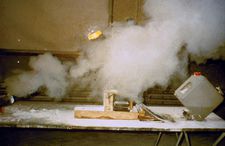 |
| Peter Fischli & David Weiss’s 16mm film The Way Things Go |
RZ: I was not very consciously thinking of that. I absolutely understand having that association or that idea that when she puts the pencil in the cup, knowing that there’s wine in it, acid. And there’s a paper with a drawing, when you pull it out, the acid destroys the drawing. That aspect of transience or that beauty which is now present that doesn’t last forever, like friendship that doesn’t last forever. It has something brittle or fragile. I understand very much that association with the Fischli & Weiss video. Maybe that’s something in that real-time storytelling when there are not so many time cuts, ellipses. Then it’s interesting to show something at one moment and other things happen and then later the person who has put the pencil in it takes it out.
Even when it’s very linear storytelling it kind of becomes non-linear. There’s the pencil, she takes it, later there’s the wine lake. The drawing being erased by the acid, so that in the real time the linear can become non-linear. In the Fischli & Weiss it’s A leads to B, B leads to C, C to D. You follow what’s happening, you see the consequences. I also like when that river is woven in a story design and that then in the linear river it becomes non-linear.
AKT: You do very interesting things with objects, in this film the yellow boxcutter, for instance. When we spoke previously, I mentioned the three realms in your film. There are the humans, then the very prominent animals, and the inanimate objects. The sponge, the wig, etc. Do you know when you start which objects are going to have a prominent position? Do any of them come up when you’re filming?
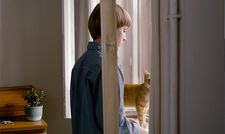 |
| Jonas (Leon Alan Beiersdorf) in The Strange Little Cat |
SZ: Not when we’re filming, then things are set already, but during the writing process it’s not clear from the very beginning which object is going to have a main role. We do treat the objects, the animals, and the characters like on a similar level and also objects get an arc. We also have an arc for the objects because of the realtime aspect. We always have to know what is where at the moment. The wig wasn’t from the very beginning an object that was wandering from character to character, it was more écriture automatique style. Actually when writing we feel very free and intuitive. It’s only later when we start to control and shape things and it’s orchestrated. Actually it’s often like this, that we are in a way bipolar: It’s chaotic and it’s orchestrated. So it’s an orchestrated chaos. In the writing process we just intuitively let things develop and we start to be strict with it.
AKT: The Girl And The Spider is part 2 of a trilogy? Will the chambermaid return in the third part?
RZ: No, the third part is The Sparrow In The Chimney. It will be like the liberation story. It’s explosive. As the title already says - the chimney is like a fireplace where things can be burnt. Maybe also a little bit disruptive, the fire. So the whole film will be more explosive and the conflicts are not on the surface. The conflicts are more in the interaction, it’s louder, maybe also a more visible aggression. Like the first part The Strange Little Cat, it’s also the portrait of a family. It’s also the movement from a prison to a utopia. It’s a utopian third part and for us the bird is the animal which can fly, which is free. We hope that we can shoot it next summer. Now we are in the preparations, we already wrote the script. Now we are in the casting process and the financing process so that we can hopefully shoot it in June, July next year.
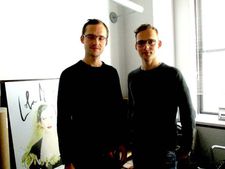 |
| Silvan Zürcher with Ramon Zürcher: “It’s an orchestrated chaos. In the writing process we just intuitively let things develop and we start to be strict with it.” |
AKT: I am very much looking forward. In your title the bird is in the chimney. Earlier this year I had a conversation with Adam Benzine who did the documentary Claude Lanzmann: Spectres of the Shoah. During our conversation he said he had a crow in his chimney and someone was coming to try to rescue the bird. Very interesting that your title is so restrictive and what you are talking about is the opposite.
Coming up - Casting The Girl And The Spider, animal wrangling, François Truffaut and names, the spectator as an alien detective, an artistic interpretation of life, question marks in dreams, the sense of Stanley Kowalsky, connecting snack bars, an animal visit and Voyage, voyage.
Deep Focus: Silvan Zürcher and Alexandre Koberidze (What Do We See When We Look At The Sky?) - Saturday, October 2, 7:00pm, Amphitheater at Lincoln Center.






















